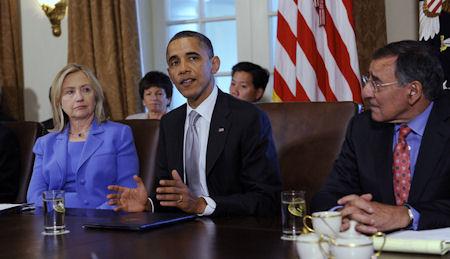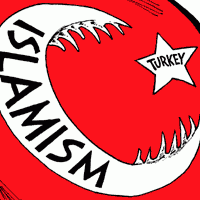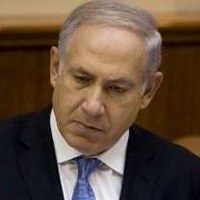![]()
Mon, Dec 05, 2011 | Rubin Reports | By Barry Rubin

U.S. President Barack Obama (C) speaks during a Cabinet meeting as U.S. Secretary of State Hillary Rodham Clinton (L) and U.S. Secretary of Defense Leon Panetta listen in the Cabinet Room of the White House as August 3, 2011in Washington, DC. (Photo by Pool/Getty Images)
Obama’s Middle East Policy: A Unified Field Theory
In the history of physics, the “unified field theory” was an attempt to bring together an understanding of all forms of energy in a single explanation. Albert Einstein tried and failed to discover this. I don’t know much about physics but I know about Middle East policy.
So here’s an effort to bring together all of Obama’s regional policy into a single analysis and explaining everything in 1100 words.
The first point is that the Obama Administration’s behavior must be divided into two phases. They overlap and feature the same kind of thinking but they are also quite separate.
Phase One, from January 2009 until December 2010 was characterized by an emphasis on Israel-Palestinian peacemaking. Obama’s Administration believed that it was possible to make rapid progress toward peace and also thought that this was essential to achieve anything else in the Middle East.
To achieve peace, they thought, required mainly putting pressure on Israel for more concessions and winning support from Arab states and Muslims by proving that the United States was more sympathetic to them than any previous presidency.
I don’t want to review all of the details but this included being more critical of Israel, lavishly flattering Arabs and Muslims, asking Arab states for help, demanding a building freeze on Israeli settlements, adding a construction stop in east Jerusalem to these demands, calling for a December 2009 Camp David summit, urging a return to the 1967 borders with minor changes, and other steps.
There were many subtle barbs here at Israel that pro-Obama and many anti-Obama writers missed. For example, the Obama Administration at first reneged on its predecessor’s promise that Israel could keep West Bank “settlement blocs.” The Obama Administration secretly agreed not to ask for a freeze in east Jerusalem and then broke that promise by publicly attacking Israel on that point. The real problem with the “1967 borders” stance was that the Obama called for an Israeli return to the 1967 borders only after which there would be negotiations to determine what changes, if any, would be made.
There are two key points to make here. The first is that U.S. policy was a total failure, something the Administration admitted. The second was that the failure came due to Arab state refusal to help and Palestinian Authority total rejectionism. The Administration has never admitted, perhaps not really understood, this factor.
It was easy to overstate the nature of the gap between U.S. policy and Israel. Most of the Administration activities were purely verbal and not material. Military aid and relationships with Israel continued. The Israeli government handled these problems pretty well. By late 2009 the relationship had been basically stabilized and not too much harm had been done.
Phase Two: Of course, the basic ideas that would characterize Phase Two were visible from the beginning of the Obama Administration. Yet here, too, the most important points were often missed. Take Obama’s Cairo speech, for example. It was criticized on various grounds — the hollow “even-handedness,” the implication that Israel was only the result of the Holocaust, the invitation of Muslim Brotherhood leaders, etc.
But the super-elephant in the room that nobody else has ever noted is this: Obama endorsed an Islamic identity for the Arabs over and above nationalism or loyalty to any specific state. It was not a pro-Arab speech but a pro-Islamist speech.
Another aspect of this policy of being nice to Islamists (or Islamist allies like Syria) and mean to historic U.S. allies was the Obama Administration’s slowness to move toward sanctions against Iran, its softness toward Turkey, Hizballah and other radical forces in Lebanon, and Syria. It even gave aid and comfort to Hamas in the Gaza Strip by pressing Israel to reduce sanctions to a minimum.
While other elements of this approach can be cited from the first few years, this approach took the lead beginning in January 2011 with the onset of the “Arab Spring.” Obama didn’t just endorse democracy, he actively worked to bring down governments friendly to the United States (Egypt, Tunisia, and Bahrain) and ignored the views and interests of other U.S. allies (Israel, Jordan and Saudi Arabia). Ignoring the State Department’s proposal of a cautious transition, he swept away the barriers to Islamist takeovers. The Libyan operation, whatever its motivations, amounted to the same thing.
During the earlier part of Phase Two — in February 2011 when the upheaval was happening — Obama was still in denial. When asked about the Muslim Brotherhood, he responded:
“I think that the Muslim Brotherhood is one faction in Egypt. They don’t have majority support in Egypt. But they are well-organized and there are strains of their ideology that are anti-U.S. There’s no doubt about it. But here’s the thing that we have to understand, there are a whole bunch of secular folks in Egypt, there are a whole bunch of educators and civil society in Egypt that wants to come to the fore as well. And it’s important for us not to say that our only two options are either the Muslim Brotherhood or a suppressed Egyptian people.
“What I want is a representative government in Egypt. And I have confidence that if Egypt moves in an orderly transition process, that we will have a government in Egypt that we can work with together as a partner.”
In other words, the people can’t get it wrong; the Brotherhood can’t win; and everything will be all right. As the months passed, however, this evolved into believing that the people can’t get it wrong; the Brotherhood will win; and everything will be all right.
The Clinton and Panetta speeches explain the new policy. Have no doubt that all of these statements are coordinated along with many others. The talking points have gone out to everyone. The phrases and concepts — like the idea that Israel is isolating itself — have been used more than once. These are not isolated errors but rather following the White House-designated script.
For example the U.S. ambassador to Belgium explains to a conference of Jewish lawyers that Muslim antisemitism stems from Israel’s policy (thus ignoring centuries of proof to the contrary) and will end if Israel reaches a peace agreement with the Palestinians (thus ignoring the fact that Islamists oppose any peace agreement and do everything possible to block it). He also showed a video of himself being warmly applauded while visiting a Muslim school. Before the stunned participants in the conference could respond, he left.
Summary: Muslims good; Islamists moderate; No peace? Israel’s fault; ears closed. Have a nice day!
In brief, the Obama Administration encourages and supports the coming to power of fanatically anti-Israel groups, then have the nerve to say Israel is becoming isolated because it isn’t making enough concessions! They encourage and support the rise of regimes that are totally against any peace with Israel or any two-state solution, then have the nerve to say that Israel can defuse the situation by making peace.
In the new phase, the Turkish Islamist regime became Obama’s guru. The Turkish model was presented as the best route for the future. To Obama’s Administration, this mean a stable democracy incorporating “moderate Islamism.” In reality, it means takeovers by radical Islamists pretending to adhere to democratic norms.
The Administration assumes that the Muslim Brotherhood would be moderate. Only the barest lip service was given to its need to prove its credentials. The Obama Administration actually welcomed Islamist victories in Egypt and Tunisia, while doing nothing to prevent that from happening in Libya. In Syria, the Obama Administration collaborated with Turkey to push Islamists to the fore in running the Syrian opposition.
In short, the Obama Administration has taken the Islamist side, the side of anti-American, anti-Western, genocide-minded toward Israel, anti-Christian, and anti-women’s rights forces. It keeps insisting that these are harmless forces, even the “good guys” who will bring about true democracy.
As a result, every traditional Arab ally in the region has been betrayed, as well as Israel. Every real democratic movement in the region has been betrayed (Egypt, Iran, Turkey, Syria, Lebanon, etc.) either by a failure to help them, by active U.S. help for their enemy, or both.
The results are predictably catastrophic. As the danger becomes increasingly obvious, as the Islamists show their fangs, the Obama Administration will ignore it. As crises develop further, the Obama Administration will either do nothing or side with the aggressors.
This kind of problem is totally unprecedented in the history of U.S. Middle East policy. There have, of course, been many mistakes. Yet policymakers have kept some ambiguity in analyzing these developments. The Obama Administration has no doubts.
Previous policymakers who are professionals dedicated to protecting U.S. interests have been open-minded to recognizing that they were wrong and adjusting policy accordingly. By now, with the landslides for Islamists in Egypt and Tunisia they would have quickly changed course. The Obama Administration is singularly closed-minded and, unfortunately, these bad tendencies are endorsed by much of the media and academic “experts” who, in the past, provided a critical perspective.
The president is systematically removing strong and knowledgeable people from top posts. The national security advisor and the secretary of defense are now political hacks, mere mouthpieces for Obama. While Secretary of State Hillary Clinton has at times showed dissent, she has now been turned into a puppet either because she accepts the policy or is just going through the motions and counting the days until she leaves office, presumably to be replaced by another pawn of the White House
It is clear that Obama will neither learn nor change and if he is given a second term, the whirlwind will be reaped.



 RSS
RSS










Obama’s Middle East Policy: A Unified Field Theory | Middle East, Israel, Arab World, Southwest Asia http://t.co/ugqIFfbB
Obama’s Middle East Policy: A Unified Field Theory | Middle East, Israel, Arab World, Southwest Asia http://t.co/ugqIFfbB